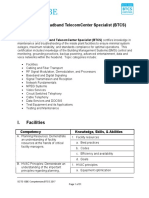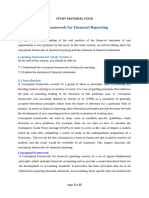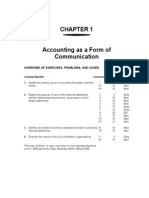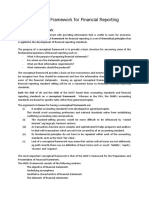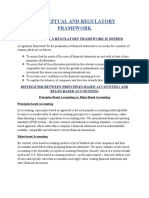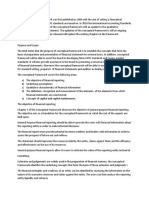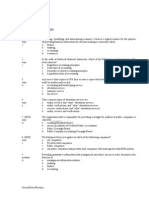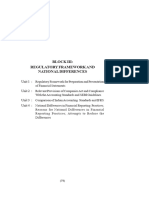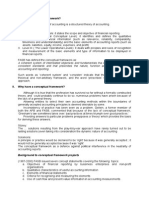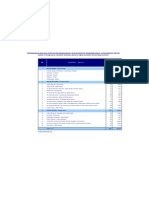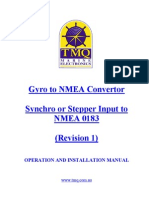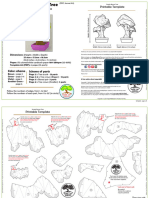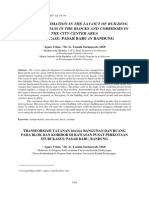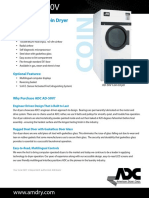0 ratings0% found this document useful (0 votes)
111 viewsConceptual Framework Sccrober
Conceptual Framework Sccrober
Uploaded by
Kazuyano DoniThe document discusses the conceptual framework project of the Financial Accounting Standards Board (FASB). It describes the early attempts to develop a conceptual framework, including committees that specified user information needs. It outlines the objectives of the FASB's conceptual framework project and the qualitative characteristics of accounting information addressed in the Statements of Financial Accounting Concepts (SFAC). The SFACs define key elements of financial statements and discuss recognition and measurement principles. The document also covers principles-based versus rules-based accounting standards, international convergence efforts, and the FASB-IASB financial statement presentation project.
Copyright:
© All Rights Reserved
Available Formats
Download as RTF, PDF, TXT or read online from Scribd
Conceptual Framework Sccrober
Conceptual Framework Sccrober
Uploaded by
Kazuyano Doni0 ratings0% found this document useful (0 votes)
111 views15 pagesThe document discusses the conceptual framework project of the Financial Accounting Standards Board (FASB). It describes the early attempts to develop a conceptual framework, including committees that specified user information needs. It outlines the objectives of the FASB's conceptual framework project and the qualitative characteristics of accounting information addressed in the Statements of Financial Accounting Concepts (SFAC). The SFACs define key elements of financial statements and discuss recognition and measurement principles. The document also covers principles-based versus rules-based accounting standards, international convergence efforts, and the FASB-IASB financial statement presentation project.
Original Description:
outline
Copyright
© © All Rights Reserved
Available Formats
RTF, PDF, TXT or read online from Scribd
Share this document
Did you find this document useful?
Is this content inappropriate?
The document discusses the conceptual framework project of the Financial Accounting Standards Board (FASB). It describes the early attempts to develop a conceptual framework, including committees that specified user information needs. It outlines the objectives of the FASB's conceptual framework project and the qualitative characteristics of accounting information addressed in the Statements of Financial Accounting Concepts (SFAC). The SFACs define key elements of financial statements and discuss recognition and measurement principles. The document also covers principles-based versus rules-based accounting standards, international convergence efforts, and the FASB-IASB financial statement presentation project.
Copyright:
© All Rights Reserved
Available Formats
Download as RTF, PDF, TXT or read online from Scribd
Download as rtf, pdf, or txt
0 ratings0% found this document useful (0 votes)
111 views15 pagesConceptual Framework Sccrober
Conceptual Framework Sccrober
Uploaded by
Kazuyano DoniThe document discusses the conceptual framework project of the Financial Accounting Standards Board (FASB). It describes the early attempts to develop a conceptual framework, including committees that specified user information needs. It outlines the objectives of the FASB's conceptual framework project and the qualitative characteristics of accounting information addressed in the Statements of Financial Accounting Concepts (SFAC). The SFACs define key elements of financial statements and discuss recognition and measurement principles. The document also covers principles-based versus rules-based accounting standards, international convergence efforts, and the FASB-IASB financial statement presentation project.
Copyright:
© All Rights Reserved
Available Formats
Download as RTF, PDF, TXT or read online from Scribd
Download as rtf, pdf, or txt
You are on page 1of 15
Chapter 2
The Pursuit of the
Conceptual Framework
Introduction
nWhat is the conceptual
framework?
Early Authoritative and
Semi-authoritative
Organizational Attempts to
Develop the Conceptual
Framewor o! Accounting
"he "rue#lood
Committee
n Committee report specified the
following four information needs
of users:
Statement on
Accounting "heory
and "heory
Acceptance
n Rationale for the
committees approach
n The approaches to
accounting theory were
condensed into
n Classical
n Decision sefulness
n !nformation "conomics#
n Criticisms of the approaches
to theory
"he FAS$%s
Conceptual
Framewor &ro'ect
n The o$%ecti&es identify the goals
and purposes of financial
accounting' whereas( the
fundamentals are the underlying
concepts that help achie&e those
o$%ecti&es#
n These concepts are designed to
pro&ide guidance in:
n )electing the transactions( e&ents
and circumstances to $e accounted
for
n Determining how the selected
transactions( e&ents( and
transactions should $e measured
n Determining how to summari*e and
report the results of e&ents(
transactions and circumstances#
SFAC (o) *
+O#'ectives o!
Financial ,eporting
$y $usiness
Enterprises-
n +ssess cash flow prospects
n Report on enterprise resources(
claims against resources and
changes in them
n Report economic resources(
o$ligations and owners e,uity
n Report enterprise performance
and earnings
n "&aluate li,uidity( sol&ency( and
flow of funds
n "&aluate management
stewardship and performance
n "-plain and interpret financial
information
(o) 2 +.ualitative
Characteristics o!
Accounting
In!ormation
n+ddresses the ,uestion:
What makes accounting
information useful?
nDe&elops a .ierarchy of
+ccounting /ualities
A Hierarchy of Accounting
Qualities
(o) / +,ecognition and
0easurement in
Financial Statements o!
$usiness Enterprises-
n)ets forth recognition criteria and
guidance on what information
should $e incorporated into financial
statements and when this
information should $e reported
nDefined comprehensi&e income as:
Re&enues "arnings
0ess: "-penses Plus or minus
cumulati&e accounting
ad%ustments
Plus: 1ains Plus or minus other
non2owner changes in
e,uity
0ess: 0osses
3 "arnings 3 Comprehensi&e !ncome
(o) / +,ecognition and
0easurement in
Financial Statements o!
$usiness Enterprises-
n 4easurement !ssues
n Definitions.
n The item meets the definition of an
element contained in SFAC No. 6#
n 4easura$ility#
n !t has a rele&ant attri$ute
measura$le with sufficient relia$ility#
n Rele&ance#
n The information a$out the item is
capa$le of making a difference in
user decisions#
n Relia$ility.
n The information is representationally
faithful( &erifia$le( and neutral#
(o) 1 +"he
Elements o!
Financial
Statements-
nDefines the ten elements of
financial statements that are
used to measure the
performance and position of
economic entities
nThese elements are
discussed
in more depth in Chapters 5
and 6#
SFAC No. 7 +2sing Cash
Flow In!ormation and
&resent 3alue in Accounting
0easurements-
n+ccounting measurement is a &ery $road
topic#
nConse,uently( the F+)7 focused on a
series of ,uestions rele&ant to
measurement and amorti*ation
con&entions that employ present &alue
techni,ues# +mong these ,uestions are:
SFAC No. 7 +2sing Cash Flow
In!ormation and &resent 3alue in
Accounting 0easurements-
n +n estimate of the future cash flows
SFAC No. 7 +2sing Cash
Flow In!ormation and
&resent 3alue in Accounting
0easurements-
n +pproaches to present &alue
n Traditional
n "-pected cash flow
&rinciples $ased vs)
,ules $ased
Accounting Standards
nContinuum ranging from
n highly rigid standards on one end
nPre&ious practice:
n 1oodwill is to $e amorti*ed o&er a 89
life until it is fully amorti*ed#
FAS$ .uestions
n Do you support the 7oards proposal for a
principles2$ased approach to # )# standard
setting?
n Will that approach impro&e the ,uality and
transparency of # )# financial accounting and
reporting?
n )hould the 7oard de&elop an o&erall reporting
framework as in !+) :?
n !f so( should that framework include a true and fair
o&erride?
n nder what circumstances should interpreti&e and
implementation guidance $e pro&ided under a
principles2$ased approach to #)# standard
setting?
n )hould the 7oard $e the primary standard setter
responsi$le for pro&iding that guidance?
n Will preparers( auditors( the )"C( in&estors(
creditors( and other users of financial information
$e a$le to ad%ust to a principles2$ased approach to
#)# standard setting?
n !f not( what needs to $e done and $y whom?
n What other factors should the 7oard consider in
assessing the e-tent to which it should adopt a
principles2$ased approach to #)# standard
setting?
n What are the $enefits and costs ;including
transition costs< of adopting a principles2$ased
approach to #)# standard setting?
n .ow might those $enefits and costs $e ,uantified?
&rinciples $ased vs)
,ules $ased
Accounting Standards
nThe +++s position
International
Convergence
nF+)7 = !+)7 pledged
n +chie&e compati$ility
n 4aintain compati$ility
FAS$-IAS$ Financial
Statement
&resentation &ro'ect
n"sta$lish common standard
n1oals
n nderstand past and present
financial position
n nderstand changes and
causes of changes
n "&aluate future cash flows
FAS$-IAS$ Financial
Statement
&resentation &ro'ect
n > Phases
n What constitutes complete set
of statements?
n Financial position
n "arnings and comprehensi&e
income
n Cash flows
n Changes in e,uity
FAS$-IAS$ Financial
Statement
&resentation &ro'ect
n > Phases
n Fundamental issues for
presentation of information
n Presentation of interim financial
information in #)# 1++P
You might also like
- SCTE ISBE BTCS Broadband TelecomCenter Specialist Certification Competencies FINAL 2017 PDFDocument31 pagesSCTE ISBE BTCS Broadband TelecomCenter Specialist Certification Competencies FINAL 2017 PDFHamdi GharsalliNo ratings yet
- Behavioural Competency DictionaryDocument27 pagesBehavioural Competency Dictionaryमान तुम्साNo ratings yet
- Accounting Theory Summary Conceptual FrameworkDocument9 pagesAccounting Theory Summary Conceptual FrameworkJesica100% (6)
- System Software NotesDocument100 pagesSystem Software NotesKavin Cavin67% (3)
- Study Material Four-1Document12 pagesStudy Material Four-1Aanuoluwa OsisanwoNo ratings yet
- CH 01Document30 pagesCH 01Go TurpinNo ratings yet
- CPAR Conceptual FrameworkDocument5 pagesCPAR Conceptual Frameworkrommel_007No ratings yet
- Cap 1, PG 25 AccoutingDocument5 pagesCap 1, PG 25 AccoutingMafer ChiangNo ratings yet
- Lecture Notes 3 - Conceptual FrameworkDocument21 pagesLecture Notes 3 - Conceptual FrameworkFreya LeeNo ratings yet
- Quiz Examples PDFDocument37 pagesQuiz Examples PDFumarrchNo ratings yet
- Financial Reporting & AnalysisDocument8 pagesFinancial Reporting & AnalysisClyton MusipaNo ratings yet
- SM Chapter 01Document36 pagesSM Chapter 01mfawzi010No ratings yet
- Section 1: Introduction To Principles of AccountsDocument6 pagesSection 1: Introduction To Principles of AccountsArcherAcsNo ratings yet
- Lecture 1 - Concepts and EthicsDocument10 pagesLecture 1 - Concepts and EthicsNikki MathysNo ratings yet
- Accounting Principles, Concepts & Conventions and Accounting StandardsDocument40 pagesAccounting Principles, Concepts & Conventions and Accounting StandardsNoothan Venkatesh VarmaNo ratings yet
- Chapter 1 Conceptual FrameworkDocument9 pagesChapter 1 Conceptual FrameworkkoketsoNo ratings yet
- Chapter 2: The Conceptual Framework: Fundamentals of Intermediate Accounting Weygandt, Kieso, and WarfieldDocument36 pagesChapter 2: The Conceptual Framework: Fundamentals of Intermediate Accounting Weygandt, Kieso, and WarfieldAppu KhanNo ratings yet
- Conceptual FrameworkDocument5 pagesConceptual FrameworkElla CunananNo ratings yet
- International Harmonization of Financial ReportingDocument8 pagesInternational Harmonization of Financial ReportingRaghu Ck100% (1)
- CF Objective of Financial ReportingDocument6 pagesCF Objective of Financial Reportingpanda 1No ratings yet
- The Conceptual Framework For Financial ReportingDocument14 pagesThe Conceptual Framework For Financial ReportingWeiling TanNo ratings yet
- A Conceptual Framework Is An Important Aspect of Modern Accounting'Document6 pagesA Conceptual Framework Is An Important Aspect of Modern Accounting'Jasim Abdul MannanNo ratings yet
- CFASDocument19 pagesCFASKuroko TetsuyaNo ratings yet
- Accounting For ManagersDocument235 pagesAccounting For Managerssajaggrover100% (2)
- The Pursuit of The Conceptual Framework: 1. Paton WilliamDocument7 pagesThe Pursuit of The Conceptual Framework: 1. Paton WilliamRoget WilliamsNo ratings yet
- Chapter 1 The Conceptual Framework: 1. ObjectivesDocument18 pagesChapter 1 The Conceptual Framework: 1. Objectivessamuel_dwumfourNo ratings yet
- Week 9 - NotesDocument10 pagesWeek 9 - Notesmark stoweNo ratings yet
- Federal Financial Management Leads To DevelopmentDocument86 pagesFederal Financial Management Leads To DevelopmentBulbul KarNo ratings yet
- (Part 2) Conceptual Framework (Doni, Bagas, Papin)Document30 pages(Part 2) Conceptual Framework (Doni, Bagas, Papin)Kazuyano DoniNo ratings yet
- Conceptual and Regulatory FrameworkDocument10 pagesConceptual and Regulatory FrameworkMohamed Yada AlghaliNo ratings yet
- By Mani SajnaniDocument47 pagesBy Mani SajnanimaniNo ratings yet
- The Conceptual Framework in Financial AccountingDocument27 pagesThe Conceptual Framework in Financial AccountingGeorge Buliki100% (3)
- The IFRS Conceptual Framework Was First Published in 1989 With The Aim of Setting A Theoretical Framework Upon Which The IFRS Standards Are Based OnDocument4 pagesThe IFRS Conceptual Framework Was First Published in 1989 With The Aim of Setting A Theoretical Framework Upon Which The IFRS Standards Are Based OnFarhan Farook AbdullaNo ratings yet
- Lesson 1: Learning ObjectivesDocument54 pagesLesson 1: Learning ObjectivesCarl Aaron LayugNo ratings yet
- MGT401 Course HandoutsDocument224 pagesMGT401 Course HandoutsUsman Ali100% (1)
- Arens Auditing and Assurance Services 13eDocument9 pagesArens Auditing and Assurance Services 13eintanfidztiraNo ratings yet
- Module 1Document18 pagesModule 1King BossNo ratings yet
- Cash Flow and Company Valuation Analysis PDFDocument20 pagesCash Flow and Company Valuation Analysis PDFDHe DestyNo ratings yet
- Com 1026 B3Document58 pagesCom 1026 B3nazmul hoqueNo ratings yet
- Conceptual Framework For Financial ReportingDocument54 pagesConceptual Framework For Financial ReportingAlthea Claire Yhapon100% (1)
- Modern Auditing Beynton Solution Manual Chapter 1Document15 pagesModern Auditing Beynton Solution Manual Chapter 1Sjifa AuliaNo ratings yet
- Far410 Chapter 2 Conceptual Framework EditedDocument60 pagesFar410 Chapter 2 Conceptual Framework EditedWAN AMIRUL MUHAIMIN WAN ZUKAMALNo ratings yet
- CONCEPTUAL FRAMEWORKDocument11 pagesCONCEPTUAL FRAMEWORKkadima.tshimpangaNo ratings yet
- Part F - Evaluation of Financial Statements (Financial Statements Discussion and Analysis)Document11 pagesPart F - Evaluation of Financial Statements (Financial Statements Discussion and Analysis)Desmond Grasie ZumankyereNo ratings yet
- Conceptual FrameworkDocument13 pagesConceptual FrameworkMarysa NovegasariNo ratings yet
- Principle Accounting-Summary Far600Document2 pagesPrinciple Accounting-Summary Far600Athirah RosleeNo ratings yet
- Chapter - 03, Process of Assurance - Planning The AssignmentDocument7 pagesChapter - 03, Process of Assurance - Planning The AssignmentSakib Ex-rccNo ratings yet
- 2. FAR Conceptual Framework and Accounting Process Notes.docxDocument8 pages2. FAR Conceptual Framework and Accounting Process Notes.docxbebiro.ciangeoNo ratings yet
- 2 (Conceptual Framework)Document14 pages2 (Conceptual Framework)Christy CaneteNo ratings yet
- Audit Risk Alert: General Accounting and Auditing Developments, 2017/18From EverandAudit Risk Alert: General Accounting and Auditing Developments, 2017/18No ratings yet
- Audit Risk Alert: General Accounting and Auditing Developments 2018/19From EverandAudit Risk Alert: General Accounting and Auditing Developments 2018/19No ratings yet
- Financial Performance Measures and Value Creation: the State of the ArtFrom EverandFinancial Performance Measures and Value Creation: the State of the ArtNo ratings yet
- Annual Update and Practice Issues for Preparation, Compilation, and Review EngagementsFrom EverandAnnual Update and Practice Issues for Preparation, Compilation, and Review EngagementsNo ratings yet
- Engagement Essentials: Preparation, Compilation, and Review of Financial StatementsFrom EverandEngagement Essentials: Preparation, Compilation, and Review of Financial StatementsNo ratings yet
- Implementing Results-Based Budget Management Frameworks: An Assessment of Progress in Selected CountriesFrom EverandImplementing Results-Based Budget Management Frameworks: An Assessment of Progress in Selected CountriesNo ratings yet
- Expert Financial Analysis: Strategies for Professional SuccessFrom EverandExpert Financial Analysis: Strategies for Professional SuccessNo ratings yet
- International Financial ManagementDocument56 pagesInternational Financial ManagementKazuyano DoniNo ratings yet
- Log TA: Importans Question (Uts)Document2 pagesLog TA: Importans Question (Uts)Kazuyano DoniNo ratings yet
- Accounting Theory (Doni Rahmad, Bagaskara, Fachriza)Document31 pagesAccounting Theory (Doni Rahmad, Bagaskara, Fachriza)Kazuyano DoniNo ratings yet
- (Part 2) Conceptual Framework (Doni, Bagas, Papin)Document30 pages(Part 2) Conceptual Framework (Doni, Bagas, Papin)Kazuyano DoniNo ratings yet
- Unit Name: System Analysis and Design Lecturer: Amsal Djunid EmailDocument2 pagesUnit Name: System Analysis and Design Lecturer: Amsal Djunid EmailKazuyano DoniNo ratings yet
- Penyelesaian Audit: Audit P Rocess Summary - Phase I (Planning)Document20 pagesPenyelesaian Audit: Audit P Rocess Summary - Phase I (Planning)suarjana66_acc_25470No ratings yet
- Strategy For Data Collection: Plans and Reports 2007/2 1Document8 pagesStrategy For Data Collection: Plans and Reports 2007/2 1Kazuyano DoniNo ratings yet
- Installment LiquidationDocument2 pagesInstallment LiquidationKazuyano DoniNo ratings yet
- Column 1 Column 2 Column 3 Column 4 Column 5Document3 pagesColumn 1 Column 2 Column 3 Column 4 Column 5Kazuyano DoniNo ratings yet
- Solutions Manual To Auditing and Assurance Services 12 TH By: Alvin A Arens, Randal J ElderDocument4 pagesSolutions Manual To Auditing and Assurance Services 12 TH By: Alvin A Arens, Randal J ElderKazuyano DoniNo ratings yet
- Article Writing Assignment Due On Week 10Document1 pageArticle Writing Assignment Due On Week 10Kazuyano DoniNo ratings yet
- Unwanted Things by Someone in Business: - Loss - Failed - Subject To Legal SanctionsDocument44 pagesUnwanted Things by Someone in Business: - Loss - Failed - Subject To Legal SanctionsKazuyano DoniNo ratings yet
- Technical Feasibility, BFS4Document21 pagesTechnical Feasibility, BFS4Kazuyano Doni100% (1)
- Tugas StatmulDocument5 pagesTugas StatmulKazuyano DoniNo ratings yet
- Tugas Audit Chpter9 Risk PrintDocument11 pagesTugas Audit Chpter9 Risk PrintKazuyano DoniNo ratings yet
- Application Form: ASTRA, A World of OpportunitiesDocument7 pagesApplication Form: ASTRA, A World of OpportunitiesKazuyano DoniNo ratings yet
- Business PlanDocument5 pagesBusiness PlanKazuyano DoniNo ratings yet
- Sektor PmaDocument1 pageSektor PmaKazuyano DoniNo ratings yet
- Prestige WP QuickStart and FAQsDocument30 pagesPrestige WP QuickStart and FAQsfelixmtNo ratings yet
- Appendix - Iii Items Under Mandatory BIS Certification Reference General Note 2 (A) of This ScheduleDocument8 pagesAppendix - Iii Items Under Mandatory BIS Certification Reference General Note 2 (A) of This ScheduledkhatriNo ratings yet
- IQA Iso9001-Iso14001Document44 pagesIQA Iso9001-Iso14001Jitendra BhosaleNo ratings yet
- Gyro To NMEA Convertor ManualDocument16 pagesGyro To NMEA Convertor ManualConstantinos Peppas100% (1)
- Gas LiftDocument24 pagesGas LiftAidil Darsam100% (1)
- Lec 5. Science Technology and Nation-BuildingDocument19 pagesLec 5. Science Technology and Nation-BuildingGiddel Narag100% (5)
- Raksh Intern.2Document34 pagesRaksh Intern.22BA19CV059 Rakshita SarangmathNo ratings yet
- 08 - Simple Bonsai Tree - TEMPLATE A3Document6 pages08 - Simple Bonsai Tree - TEMPLATE A3Jorge EncaladaNo ratings yet
- FUSION ManualDocument119 pagesFUSION ManualRodrigo GarciaNo ratings yet
- LEVEL 1 - Bulk Density of Coarse Aggregate PDFDocument4 pagesLEVEL 1 - Bulk Density of Coarse Aggregate PDFdzikryds0% (1)
- გაბრიელ გარსია მარკესი - სიყვარული ჟამიანობის დროს PDFDocument397 pagesგაბრიელ გარსია მარკესი - სიყვარული ჟამიანობის დროს PDFMariam KapanadzeNo ratings yet
- Pressure Gauge - Isolator Valve Type AF 6: Nominal Size 6 Series 4X Maximum Operating Pressure 300 BarDocument4 pagesPressure Gauge - Isolator Valve Type AF 6: Nominal Size 6 Series 4X Maximum Operating Pressure 300 BarMSc Kostic MilosNo ratings yet
- Revenue Grade Metering StandardsDocument2 pagesRevenue Grade Metering StandardsAlejandra Maria TiradoNo ratings yet
- Sasiu2 Suzuki VL800Document20 pagesSasiu2 Suzuki VL800Crisan SorinNo ratings yet
- Y Strainer 50 MM DiaDocument27 pagesY Strainer 50 MM Diamudassir mNo ratings yet
- Pasar BaruDocument17 pagesPasar BaruJessica CarolineNo ratings yet
- Plumbing Code Quiz 2 Answer KeyDocument4 pagesPlumbing Code Quiz 2 Answer KeyEdmond BautistaNo ratings yet
- Pile InfoDocument1 pagePile InfoArvin BhurtunNo ratings yet
- The Coming Free Energy RevolutionDocument14 pagesThe Coming Free Energy RevolutionToneNo ratings yet
- MS Excel Lesson 3 Using Office BackstageDocument14 pagesMS Excel Lesson 3 Using Office BackstageHANNAH DESIREE CASURRANo ratings yet
- PSpice ManualDocument121 pagesPSpice ManualJean AguiarNo ratings yet
- LOGIC RESET ParametratDocument2 pagesLOGIC RESET ParametratILIR SLLAMNIKUNo ratings yet
- Adc 50Document2 pagesAdc 50mairimsp2003No ratings yet
- Gray Laura ResumeDocument2 pagesGray Laura Resumeapi-286313605No ratings yet
- Zero BDocument1 pageZero Bmaksudur4No ratings yet
- Investigating Transformer Failures PDFDocument9 pagesInvestigating Transformer Failures PDFSAURABH DIXITNo ratings yet
- Class PathDocument7 pagesClass Pathsaati143431No ratings yet
- A5hf1 Intro Part1Document41 pagesA5hf1 Intro Part1Huỳnh Minh ĐứcNo ratings yet
